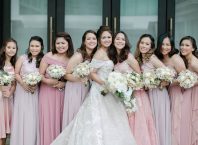The wedding ceremony itself took three days. On the first, the bride and groom, borne on separate processions, were brought to the house of the babaylan (priest), who joined their hands over a plate of raw rice and blessed them. The party then repaired to the arbor for feasting well until the following day.
On the third day, again before the babaylan, bride and groom performed something of a blood compact. With a thorn the priest pricked their breasts and drew a little blood. He joined their hands and bade them declare, thrice, that they loved each other. He then fed them cooked rice from the same plate and made them drink, from the same singalong (a wooden cup), of the blood drawn from both, mixed with a little water. Binding their hands and necks together with a cord, he declared, “This man is now one with this woman. Let all of you be witnesses to this union.” Like the exchange of rings in a Christian ceremony, the couple then gave each other a jewel. This ritual, called talingbuhol, signalled the completion of the wedding and start of yet another round of wedding feasts anywhere from one to two weeks, or for as long as the groom’s largesse held out. On the last day of feasting, the bride was ceremoniously bathed by her godmothers and decked again in her wedding finery, solemnly and finally delivered to her husband in their new house.
. . . . . . . . . . . . . . . . . . . . . . . . . . . . . . . . . . . . . . . . . . . . . . . . . . . . . . . . . . . . . . . . . . . . . . .
Source:
Alvina, C. & Sta. Maria, F. 1987. Essays on Philippine Culture.




